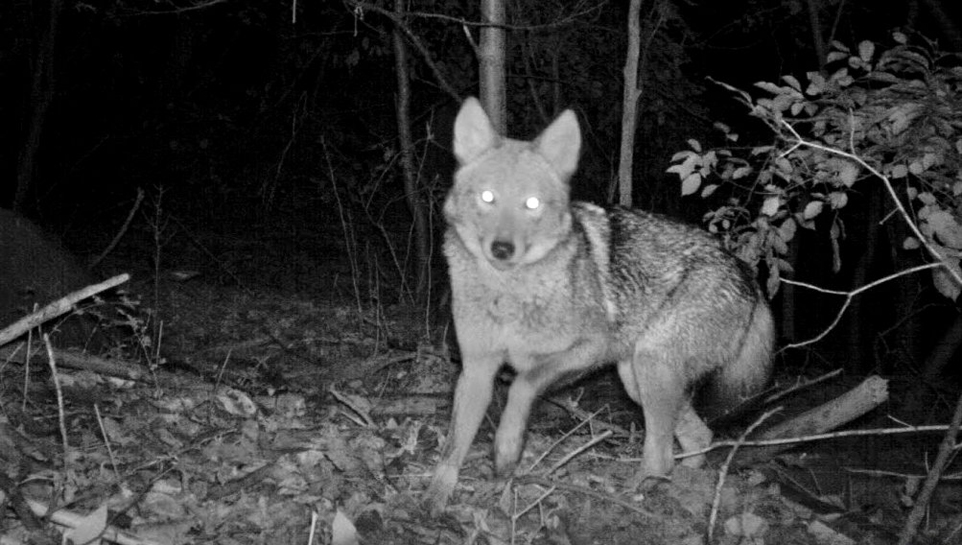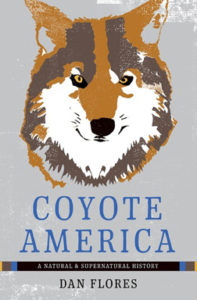The Spell Of The Urban Coyote
Though clever anywhere, coyotes might just be showing off a ‘supergenius’ for city life, according to the fascinating new book “Coyote America,” by Dan Flores

The “sidelong glance” and “characteristic lope” of the coyote. Dan Flores points out that coyotes, unlike gray wolves, are native only to North America and have never left. Photo: Don McCullough/Flickr.
By Vicki Croke
Coyotes are smart, beautiful, and resilient. Furthermore, says Dan Flores, author of a fascinating new biography of the species, they’re here to stay, and not just in pockets of wilderness, but right along beside us, wherever we live, from coast to coast.
That’s not hyperbole. Evidence shows that there is a coyote living within a mile of every person in the United States.
These little predators show up in extreme urban settings from Los Angeles (for more than 100 years) to New York City. In Portland, Oregon, in 2002, a coyote was photographed curled up on a seat on the airport’s light-rail train, Flores writes in “Coyote America: A Natural and Supernatural History.” And during a heatwave in Chicago in 2007, one coyote even strolled through the open door of a Quiznos franchise to lie down in a cooler filled with bottled drinks.

So, a coyote walks into a sandwich shop–that’s not the start of a joke, but the real story of one coyote cooling down among bottle drinks in Chicago in 2007. Photo: Scott Stewart/Chicago Sun Times/AP.
We have seemed shocked by these stories over the last dozen plus years, but the coyote knack for tolerating us goes back a long way. “For the 15,000 years since we humans have been in North America,” Flores, a historian of the American West, writes, “coyotes have always been capable of living among us. Something about our lifestyle has always drawn coyotes to human camps, villages, and cities.” Obviously it hasn’t always been the sandwich shop air conditioning. Instead, Flores reports, the “something” that compels coyotes to be close to us, is largely about the mice and rats that human populations support.
And, for clever coyotes, it’s also about safety.
Despite more than a hundred years of barbaric and widespread efforts to exterminate these predators here in the United States, (efforts that continue today), they survive. In fact, especially in cities, they thrive.

An oasis of wild in the city: Pugsley Creek Park, Bronx, NY in 2011. Photo: Gotham Coyote Project.
Flores reports that survival studies make that clear: while only 13 percent of rural coyote pups make it to adulthood, a whopping 61 percent of urban coyote pups do. And though rural coyotes have an average life span of less than three years, in the city, Flores tells us, where food is plentiful and no one is hunting or trapping them, coyotes are living to 12 or 13.
They’re even innovating to stay safe. Cars eat up a lot of wild animals, but some coyotes appear to be gaining an understanding of median strips and lighter nighttime traffic patterns.
 Coyotes, like people, are individuals. And Flores reports that “supergenius” problem-solving coyotes might be the fittest survivors in the complicated city.
Coyotes, like people, are individuals. And Flores reports that “supergenius” problem-solving coyotes might be the fittest survivors in the complicated city.
How are we humans doing with the cohabitation process? Well, for citizens of the U.S., there’s been a learning curve. But the fact is that we are getting better at it too. Flores reports that a fear of coyotes by residents of Chicago has diminished even as the coyote population has grown.
A rising comfort level makes sense. It’s rational. In all our time together there are but two recorded instances of coyotes killing people: A 3-year-old girl in an LA suburb in 1981. And a 19-year-old woman in Nova Scotia in 2009 (This is not to diminish the tragedy of each.)
But let’s face it: Our attitudes about any predator, particularly coyotes, has not always been rational.
Coyote superpowers from “Coyote America”:
- The fission-fusion advantage: “Most predators are either solitary or social, not both. But like us, the coyote gets to have it both ways.”
- Coyotes appear to be able to conduct something that works out like a self-census by ear. They listen to the howls of their compatriots under starlight—and produce larger litters when there are fewer coyotes around.
- The more we’ve tried to kill off coyotes, the stronger they’ve come back: splitting up their packs, increasing litter sizes, expanding their territories.
We Americans have tried to kill them off over hundreds of years. Coyotes were widely blamed for what we considered misdeeds—like killing elk, but in the 1930s, naturalist Adolph Murie showed that the coyotes were eating mostly mice and gophers and insects.

Dan Flores, a historian of the American West who lives in New Mexico, writes: “Yodeling coyote music is inseparable from the silvery wash of planets and the high moons of the winter night skies of this part of the world.” Courtesy of Dan Flores.
Despite his report, government programs continued to poison, shoot, and trap them. All in all, between 1915 and 1947 nearly two million were killed. From 1945 to 1971, the count was anywhere from 3.6 million to 6 million. And, today, we are still funding the slaughter of half a million a year.
When you read this book, this shared history of two species, there is much to admire about the coyote. And for us humans? Well, there’s hope.
